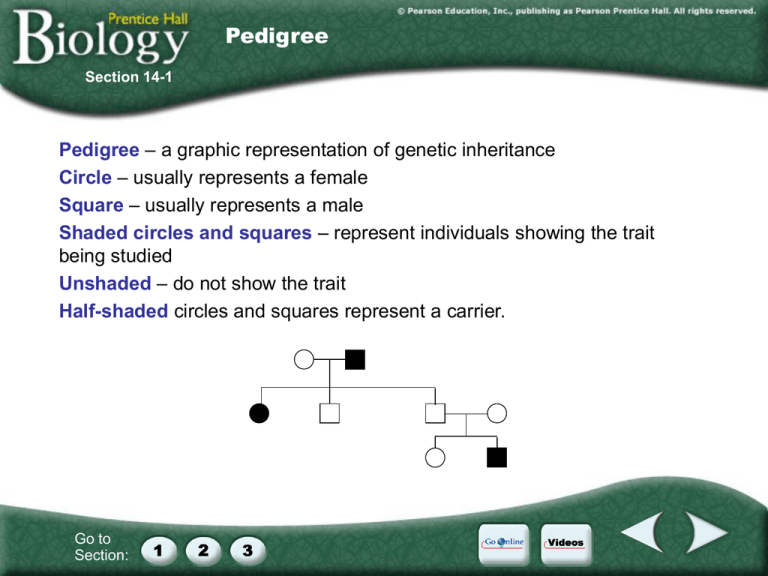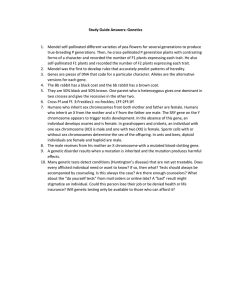Section 14-1
advertisement

Pedigree Section 14-1 Pedigree – a graphic representation of genetic inheritance Circle – usually represents a female Square – usually represents a male Shaded circles and squares – represent individuals showing the trait being studied Unshaded – do not show the trait Half-shaded circles and squares represent a carrier. Go to Section: Figure 14-3 A Pedigree Section 14-1 A circle represents a female. A horizontal line connecting a male and female represents a marriage. A half-shaded circle or square indicates that a person is a carrier of the trait. A completely shaded circle or square indicates that a person expresses the trait. Go to Section: A square represents a male. A vertical line and a bracket connect the parents to their children. A circle or square that is not shaded indicates that a person neither expresses the trait nor is a carrier of the trait. Pedigree Activity Go to Section: Karyotype Karyotype – chart of chromosome pairs that may be used to determine a genetic disorder. Homologous- matching chromosomes Autosomes- chromosomes that are not sex chromosomes; normally humans have 22 pair Sex Chromosomes – the 23rd pair of chromosomes; females have a matching set of homologous chromosomes (XX), males do not (XY) Go to Section: Karyotype Picture Go to Section: Interest Grabber Section 14-2 Gender Benders You may remember that in humans, the sperm cells may carry an X chromosome or a Y chromosome, while egg cells have only X chromosomes. Sometimes, errors during meiosis in one of the parents produce offspring with an abnormal number of sex chromosomes. Go to Section: Disorders Nondisjunction Changes in Chromosome Numbers Nondisjunction – failure of chromosomes to separate properly during the process of meiosis Down Syndrome (Trisomy 21) – extra 21st chromosome Turner Syndrome – individual is missing a sex chromosome 45XO Klinefelter Syndrome – individual has an extra X chromosome 47 XXY Go to Section: Disorders Codominance in Humans Sickle Cell Anemia – affects black Americans whose families originated in Africa and in white Americans whose families originated in the countries surrounding the Mediterranean Sea. An individual who is homozygous for sickle cell will suffer from the disease. If the person is heterozygous, they only carry the disease. They are codominant for the disease. In sickle cell the protein hemoglobin differs by one amino acid. This defective hemoglobin forms crystal-like structures that change the shape of the red blood cells. Go to Section: Sickle Cell Picture of a sickle cell Go to Section: Genetic Disorders Tay-Sachs disease -recessive disorder of the central nervous system; affects individuals of Jewish descent. Phenylketonuria (PKU)-a recessive disorder that results from the absence of an enzyme that converts one amino acid to a different amino acid. Cystic fibrosis -common genetic disorder among white Americans. It is due to a defective protein in the plasma membrane. CF results in the formation and accumulation of thick mucus in the lungs and digestive tract. Go to Section: Figure 14-8 The Cause of Cystic Fibrosis Section 14-1 Chromosome #7 CFTR gene The most common allele that causes cystic fibrosis is missing 3 DNA bases. As a result, the amino acid phenylalanine is missing from the CFTR protein. Go to Section: Normal CFTR is a chloride ion channel in cell membranes. Abnormal CFTR cannot be transported to the cell membrane. The cells in the person’s airways are unable to transport chloride ions. As a result, the airways become clogged with a thick mucus. Sex-Linked Traits in Humans Red – green color blindness – cannot differentiate between red and green. XCY – normal XcY – colorblind XCXC – normal XCXc – normal XcXc – colorblind Go to Section: Go to Section: Figure 14-13 Colorblindness Section 14-2 Father (normal vision) Colorblind Normal vision Male Female Daughter (normal vision) Son (normal vision) Daughter (carrier) Son (colorblind) Mother (carrier) Go to Section: Sex Linked Traits in Humans Hemophilia – X-linked disorder that causes a problem with blood clotting. XHY – normal XhY – hemophilia XHXH – normal XHXh – normal XhXh – hemophilia Go to Section: Multiple Alleles in Humans ABO blood groups are determined by multiple alleles. Type A – contains A antigens (alleles) Type B – contains B antigens Type AB – contains both A and B Type O – has neither A nor B Table 12.3 page 331 Rh antigen – positive has the antigen Negative does not. O – universal blood donor AB – universal blood recipient Go to Section: Interest Grabber Section 14-3 Bioethics and You As you become more aware of scientific advances in genetics, you might realize that with the ability to manipulate genes, there comes responsibility. This ability provides an opportunity to improve the lives of many people. But there is also a potential for errors or intentional misuse of the technology. Go to Section: Interest Grabber continued Section 14-3 Working with a partner, answer the following questions. 1. In what type of situation do you think genetic engineering—changing the genes of organisms—is warranted? Explain your reasoning about your position. If you do not think that genetic engineering is ever warranted, explain your reasons for your position. 2. In what type of situation do you think genetic engineering might be misused? Suggest limits that might be placed on the manipulation of genes to avoid its misuse. Go to Section: Videos Click a hyperlink to choose a video. Human Sex Determination Nondisjunction Point Mutation Video 1 Human Sex Determination Click the image to play the video segment. Video 2 Nondisjunction Click the image to play the video segment. Video 3 Point Mutations Click the image to play the video segment. Go Online Links from the authors on DNA samples Career links on geneticists More information on the Human Genome Project Interactive test For links on pedigrees, go to www.SciLinks.org and enter the Web Code as follows: cbn-4141. Interest Grabber Answers 1. This pedigree shows the inheritance of attached ear lobes. Which parent has attached ear lobes? The father 2. How many children do the parents have? Which child has attached ear lobes? Three; the daughter has attached ear lobes. 3. Which child is married? Does this child’s spouse have attached ear lobes? Do any of this child’s children have attached ear lobes? The second son; no; yes, the daughter Interest Grabber Answers 1. On a sheet of paper, construct a Punnett square for the following cross: XX x XY. Fill in the Punnett square. What does the Punnett square represent? According to the Punnett square, what percentage of the offspring from this genetic cross will be males? What percentage will be females? One half of the offspring will be males; the other half, females. 2. On a sheet of paper, construct a Punnett square for the following cross: XXX x XY. Fill in the Punnett square. How is this Punnett square different from the first one you constructed? What might have caused this difference? One of the gametes has two X chromosomes instead of just one. This might have resulted from a mistake in meiosis: Instead of separating, the pair of X chromosomes stayed together. 3. How do the offspring in the two Punnett squares differ? Instead of two XX and two XY offspring, there are one XX and one XY (which are normal), plus one XXX and one XXY (which are abnormal). Interest Grabber Answers 1. In what type of situation do you think genetic engineering—changing the genes of organisms—is warranted? Explain your reasoning about your position. If you do not think that genetic engineering is ever warranted, explain your reasons for your position. Students’ answers likely will include medicinal uses of genetic engineering, such as gene therapy for genetic diseases and production of needed substances such as insulin. Some students may object to all genetic manipulations. 2. In what type of situation do you think genetic engineering might be misused? Suggest limits that might be placed on the manipulation of genes to avoid its misuse. Students’ answers may include the “designing” of human babies with desirable traits and the cloning of humans. Some students may object to genetically altered foods. This slide is intentionally blank.








